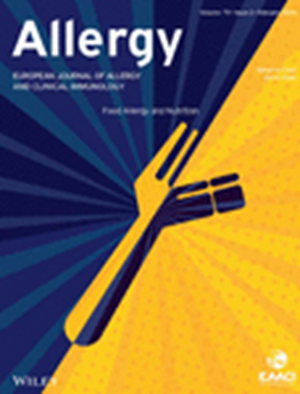Early-life exposure to residential greenness and risk of asthma in a U.S. bronchiolitis cohort.
IF 12.6
1区 医学
Q1 ALLERGY
引用次数: 0
Abstract
INTRODUCTION Severe bronchiolitis (i.e., bronchiolitis requiring hospitalization) is linked to childhood asthma development. Despite a growing understanding of risk factors for developing post-bronchiolitis asthma, protective factors remain unclear. In this study, we aimed to investigate whether exposure to residential greenness between birth and bronchiolitis hospitalization is associated with asthma and atopic asthma development by age 6 years. METHODS We analyzed a US severe bronchiolitis cohort from hospitalization to age 6 years, investigating how the normalized difference vegetation index (NDVI) and chlorophyll index green (CI green), measured in small (100 m) and large (500 m) radiuses around homes, relate to asthma and atopic asthma by age 6 years. We also explored whether maternal antibiotic use, daycare attendance, and respiratory virus type during hospitalization act as effect modifiers. RESULTS The study cohort included 861 infants, with 239 (28%) developing asthma by age 6 years-152 atopic, 17 nonatopic, and 70 unclassified. Early life residential exposure to high NDVI and CI green levels was associated with lower odds of asthma (ORAdj for NDVI within a 100 m radius, 0.18; 95% CI, 0.05-0.78; and ORAdj for CI green levels within a 100 m radius, 0.53; 95% CI, 0.31-0.90). Associations also were significant for the development of atopic asthma (ORAdj 0.16; 95% CI, 0.03-0.96; and ORAdj 0.46; 95% CI, 0.25-0.92; respectively). Results were similar for the 500 m radius exposures. No effect modification was noted. CONCLUSION In a U.S. bronchiolitis cohort, exposure to residential greenness between birth and bronchiolitis hospitalization is linked to lower asthma and atopic asthma risk by age 6 years.美国支气管炎队列中早年接触住宅绿化与哮喘风险的关系。
引言 严重的支气管炎(即需要住院治疗的支气管炎)与儿童哮喘的发生有关。尽管人们对罹患支气管炎后哮喘的风险因素有了越来越多的了解,但保护性因素仍不明确。在这项研究中,我们旨在调查从出生到支气管炎住院期间接触住宅绿化是否与 6 岁时哮喘和特应性哮喘的发展有关。方法 我们分析了美国严重支气管炎队列从住院到 6 岁的情况,调查了在住宅周围小半径(100 米)和大半径(500 米)测量的归一化差异植被指数(NDVI)和叶绿素绿色指数(CI 绿色)与 6 岁时哮喘和特应性哮喘的关系。我们还探讨了母亲使用抗生素、日托服务和住院期间呼吸道病毒类型是否会对其产生影响。结果研究队列包括 861 名婴儿,其中 239 人(28%)在 6 岁时患上哮喘--152 人是特应性哮喘,17 人是非特应性哮喘,70 人未被分类。早年居住地暴露于高 NDVI 和 CI 绿色水平与较低的哮喘几率有关(半径 100 米内 NDVI 的 ORAdj 为 0.18;95% CI 为 0.05-0.78;半径 100 米内 CI 绿色水平的 ORAdj 为 0.53;95% CI 为 0.31-0.90)。与特应性哮喘的发生也有明显关系(分别为 ORAdj 0.16;95% CI,0.03-0.96;和 ORAdj 0.46;95% CI,0.25-0.92)。半径为 500 米的暴露结果类似。结论 在美国支气管炎队列中,从出生到支气管炎住院期间接触住宅绿化与 6 岁时哮喘和特应性哮喘风险较低有关。
本文章由计算机程序翻译,如有差异,请以英文原文为准。
求助全文
约1分钟内获得全文
求助全文
来源期刊

Allergy
医学-过敏
CiteScore
26.10
自引率
9.70%
发文量
393
审稿时长
2 months
期刊介绍:
Allergy is an international and multidisciplinary journal that aims to advance, impact, and communicate all aspects of the discipline of Allergy/Immunology. It publishes original articles, reviews, position papers, guidelines, editorials, news and commentaries, letters to the editors, and correspondences. The journal accepts articles based on their scientific merit and quality.
Allergy seeks to maintain contact between basic and clinical Allergy/Immunology and encourages contributions from contributors and readers from all countries. In addition to its publication, Allergy also provides abstracting and indexing information. Some of the databases that include Allergy abstracts are Abstracts on Hygiene & Communicable Disease, Academic Search Alumni Edition, AgBiotech News & Information, AGRICOLA Database, Biological Abstracts, PubMed Dietary Supplement Subset, and Global Health, among others.
 求助内容:
求助内容: 应助结果提醒方式:
应助结果提醒方式:


